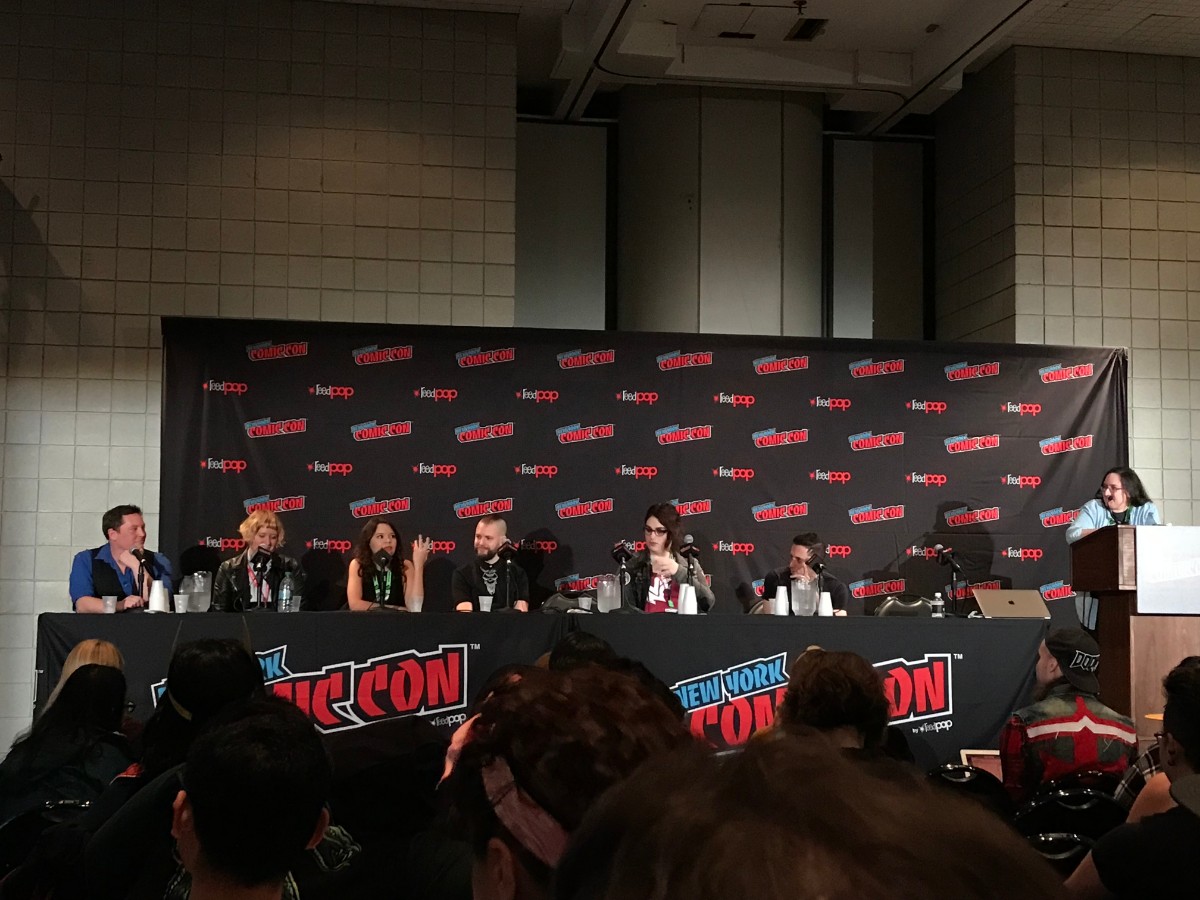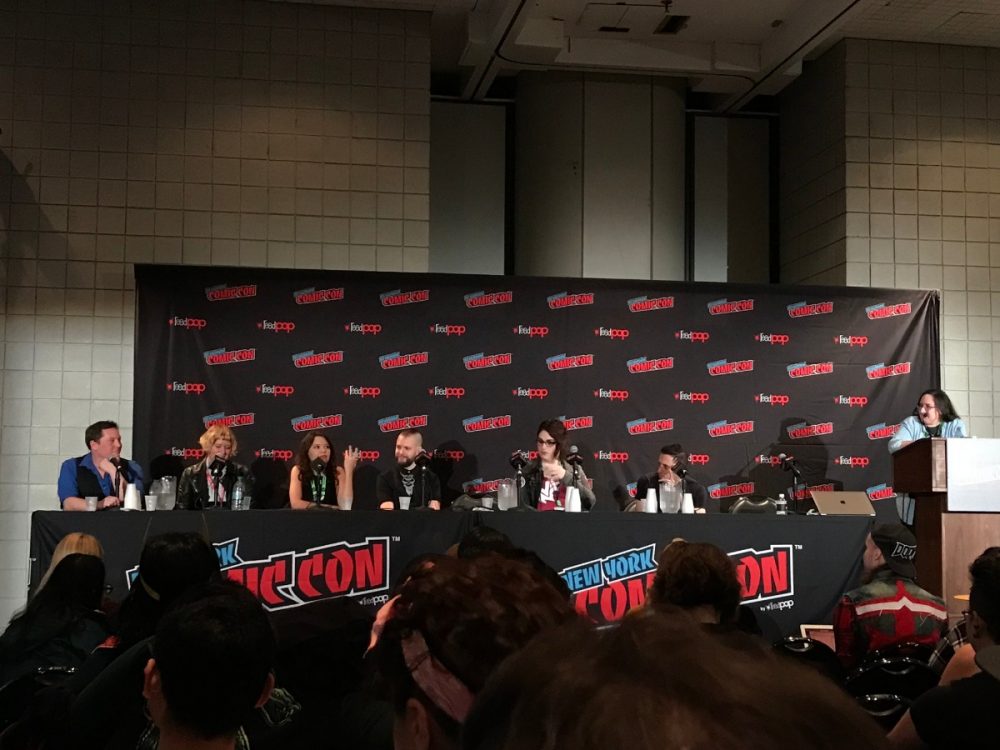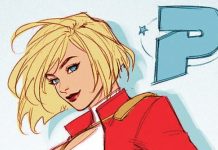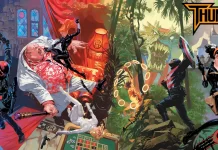By William Henderson
“Whatever happened to She-Hulk’s best friend Louise?”
Representation matters, whether you’re a pre-teen struggling to label how you feel, or a queer comic book creator tired of gatekeepers preventing you from presenting your story how you want to tell it, or so panelists at Thursday’s 7th annual New York TimesOUT LGBTQ in Comics Panel said.
Hosted by New York Times Book Review Editor Jude Biersdorfer, the panel – the second LGBTQ panel of the day – included Rich Bernatovech (Sentinels), Amy Reeder (Rocket Girl), Luciano Vecchio (Guardians of the Galaxy), Lion Forge Comics Editor Desiree Rodriguez, Magdalene Visaggio (Kim & Kim), and Steve Orlando (Wonder Woman), and each separately talked about the value of seeing yourself in a comic book, the types of stories that they wished they had had as children, the types of stories they’d like to tell, and how to succeed as a queer creator in a “cisgender heterosexual business.”
Which is why you can buy a book that shows (in shadow and rather chastely) Bruce Wayne’s penis, but you’ll never buy a book in which Clark Kent admits that he experimented with a male friend in Smallville.
“If it did happen,” said Orlando, “that would be the loudest possible statement.”
But it won’t happen. Clark Kent won’t admit to a secret boyfriend in Smallville, and Orlando made sure that the audience of about 200 people knew that he was simply suggesting that having a character like Clark Kent come out would mean more than having a D-lister come out.
Why so few queer characters in mainstream comic books? Because when writers pitch queer characters, they’re not told no, they’re given the go-ahead… but only if the identity is organic to the story, said Visaggio, who in her recent Dazzler one-shot wanted to include several queer characters but was forced to leave most of them on the cutting-room floor.
Which is part of the problem facing queer creators, said Visaggio. Queer characters in comic books don’t reflect queer people in real life.
“You don’t see Northstar hanging out with queer people ever,” said Visgagio, who added that she has few straight friends and hangs out primarily with other queer people. This group of people make up her circle of friends, her chosen family, and you’d be hard-pressed to find a group of friends like her group of friends in a mainstream comic book.
Queer people in mainstream comic books are pigeonholed into specific types of stories, said Orlando. They’re either strapped with the “coming out” story, the “bashed” story, or the “wedding cake” story. They have friends, but these friends are on the periphery and come in and out of focus depending on who is writing the character.
“What happened to She-Hulk’s best friend Louise?” Visaggio rhetorically asked, and other panelists agreed, listing friendships that have gone by the wayside as writers are forced to write six-issue story arcs that will work later as self-contained trades rather than the type of long-game storytelling that made Chris Claremont’s run on Uncanny X-Men as good as it was (or is, I guess, if you’ve never read it before, and if you’ve never read it before, then do so, soon).
Continuing to riff on She-Hulk, a character Visaggio admitted she loved and has thought a lot about recently, she said that she saw (as a young trans woman) and continues to see (as a trans comic book writer), a metaphor for the transgender experience. Think about it. She-Hulk is bigger and taller than other women, and she can never really entirely fit into any room other than a room full of Avengers because they’re freaks too, said Visaggio.
But in some of Visaggio’s favorite She-Hulk stories, she and Louise (the once and occasional Blonde Phantom) ran around the universe, kicking ass and taking names.
But creator-owned, that’s another story, and a story that the panelists have explored. Take Visaggio’s Kim & Kim. She said she’s writing the book she would have wanted to read when she was 14, so that future 14-year-olds like her have that type of story to read. Or Reeder, who quipped at one point that she’s “a big believer in making new characters in general.”
“We need a lot more [stuff] out there. I don’t like rules. I don’t like too many hands in what I do,” Reeder added.
Bernatovech and Vecchio separately agreed.
Orlando, who is currently wrapping his short run on Wonder Woman and prepping to introduce in December his take on J’onn J’onzz for Martian Manhunter, says that in genre comics, you get to deal with an idea of “otherness,” and who better than the last Martian to explore how to be “other.”
J’onzz, said Orlando, is an other in a world of others, given his telepathy, shape-shifting ability, and being a Martian. Add to that his belief that he’s responsible for the death of his planet and of his family and his attempt to assimilate as a detective on Earth, and you’ve got the story of one man’s attempt to reconcile both sides of himself.
Orlando compared J’onzz’ attempts at reconciling both parts of himself to how he’s had to reconcile (still has to?) being a bisexual half-Jewish man. Unsure if he had done a good enough job selling the idea of his next monthly book from DC Comics, Orlando played up the sexy side of J’onzz.
“Sex on Mars is unlike anything you guys have seen before,” Orlando said. “It’s moist.”
The panelists talked about other characters they’d like to “rescue” from back issue bins. Vecchio would like to rescue Extraño, one of DC’s first openly gay characters, from being a footnote. Bernatovech would like to see the original members of Alpha Flight given another chance. And Rodriguez, the only non-creator on the panel, joked at one point that she’d like to edit “the book that shows Superman’s bits.”
As for She-Hulk’s best friend Louise… if you believe Wikipedia (and I admit believing Wikipedia is a crap shoot even on good days) then the character apparently hasn’t appeared in a comic book in seven years.








